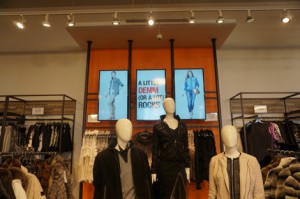Gail Chiasson, North American Editor
Last Call Studio, the off-price brand of Neiman Marcus, was interested in using digital signage to increase sales, but was worried about trying something new without assured return on investment, so turned to Scala to find a solution.
 Scala recommended a tiered approach to curb upfront costs: piloting digital signage at a single store; gathering statistics and tweaking signage according to the findings; and then adding more locations as signage was found to be successful.
Scala recommended a tiered approach to curb upfront costs: piloting digital signage at a single store; gathering statistics and tweaking signage according to the findings; and then adding more locations as signage was found to be successful.
To minimize upfront costs, Scala selected a test store in Rockville, Maryland, , where it installed nine 46” screens touting three specific product groups: dresses, shoes and handbags. 15 clips per area were set at a repetition rate of six minutes, and detailed, time-stamped sales and customer traffic data was recorded, along with anecdotal information from sales associates and customers. Conversion rates for dresses and shoes rose considerably, while handbag conversions declined. It was determined that handbag advertising clips were underrepresented, and correlating in-store inventory was insufficient. Increasing the number of handbag ads and assuring matching inventory netted a 30% increase in sales compared to the first signage iteration.
 “The use of in-store digital displays matched with Scala Advanced Analytics provided us the opportunity to dig deeper into targeted merchandise categories in a way we have never been able to,” says Ignaz Gorischek, vice-president, store development. “This allowed us to align inventory with digital messaging at peak shopping times, creating a more engaging experience between us and our customers.”
“The use of in-store digital displays matched with Scala Advanced Analytics provided us the opportunity to dig deeper into targeted merchandise categories in a way we have never been able to,” says Ignaz Gorischek, vice-president, store development. “This allowed us to align inventory with digital messaging at peak shopping times, creating a more engaging experience between us and our customers.”
Using Scala Advanced Analytics, it was found that the conversion rate for dresses and shoes had gone up substantially. Sales staff and customers who were interviewed said the digital ads inspired store visitors to browse the merchandise, try things on and often buy targeted items.
On the other hand, handbag conversions declined. In a revisit of digital media, Scala found that handbags were only featured in three of the 15 advertising clips. While lack of customer exposure might explain a neutral reaction, it didn’t explain a dip in sales.
The conclusion was that when in-store inventory didn’t correlate with the images being advertised, customer frustration resulted and the assumption that generic images would suffice was disproved. The sales staff attested that customers were paying attention to specific product images and then actively seeking the product out within the store. For example,
when shown a specific dress on screen, the dress sold out quickly, when prior to that sales had been below average.
After better aligning digital content with store inventory and increasing frequency of handbag ads, Scala and Last Call Studio ran a second iteration at the pilot store as well as at a second store in Dallas, Texas. Shortly after, handbags showed a positive lift of about 30%. Both dress and shoe sales also increased, and it was found that after seeing a specific digital ad, customers who sought out that specific item often purchased it on the spot.
By leveraging analytics to improve results for Last Call Studio, Scala helped to drive their sales results with digital media. Overall, it was found that displaying relevant messages at a sufficient frequency creates a positive in-store experience that helps achieve sales results. Following Scala’s recommendation, Last Call stores was able to reduce upfront costs and significantly increase conversion rates for the promoted products.

Follow DailyDOOH